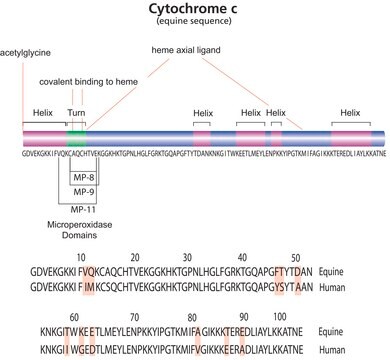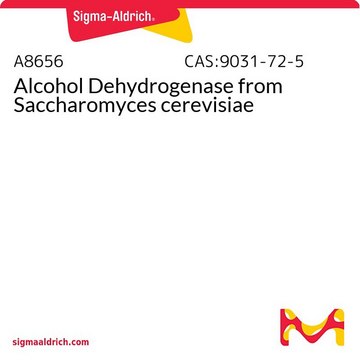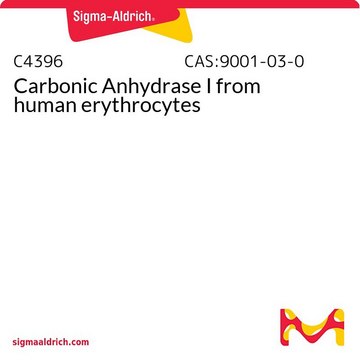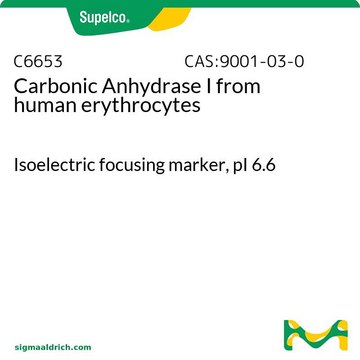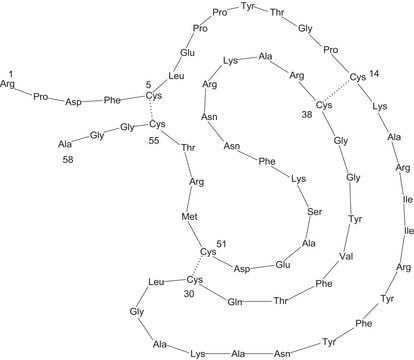C7025
Anidrase carbônica
BioReagent, suitable for GFC marker
Sinônimo(s):
Carbonato desidratase, Carbonato hidrolase
Faça loginpara ver os preços organizacionais e de contrato
About This Item
Produtos recomendados
linha de produto
BioReagent
Nível de qualidade
Formulário
powder
peso molecular
~29,000
embalagem
vial of 15 mg
adequação
suitable for GFC marker
temperatura de armazenamento
−20°C
Procurando produtos similares? Visita Guia de comparação de produtos
Aplicação
Carbonic Anhydrase from bovine erythrocytes is a bioreagent used in gel filtration chromatography, protein chromatography and plasma and blood proteins. Carbonic anhydrase has been used to study compounds widely known to have anticancer properties against human cancers and that act as diuretic, antibacterial, antifungal, antitubercular and leishmanicidal agents.
Gel filtration molecular weight marker
Palavra indicadora
Danger
Frases de perigo
Declarações de precaução
Classificações de perigo
Resp. Sens. 1
Código de classe de armazenamento
11 - Combustible Solids
Classe de risco de água (WGK)
WGK 3
Ponto de fulgor (°F)
Not applicable
Ponto de fulgor (°C)
Not applicable
Equipamento de proteção individual
Eyeshields, Gloves, type N95 (US)
Escolha uma das versões mais recentes:
Já possui este produto?
Encontre a documentação dos produtos que você adquiriu recentemente na biblioteca de documentos.
Os clientes também visualizaram
Wisath Sae-Lee et al.
Cell reports, 40(3), 111103-111103 (2022-07-21)
Red blood cells (RBCs) (erythrocytes) are the simplest primary human cells, lacking nuclei and major organelles and instead employing about a thousand proteins to dynamically control cellular function and morphology in response to physiological cues. In this study, we define
Do Hyeon Kim et al.
Journal of microbiology and biotechnology, 30(12), 1905-1911 (2020-10-14)
Homoserine dehydrogenase (HSD) catalyzes the reversible conversion of L-aspartate-4- semialdehyde to L-homoserine in the aspartate pathway for the biosynthesis of lysine, methionine, threonine, and isoleucine. HSD has attracted great attention for medical and industrial purposes due to its recognized application
Leo Syrjänen et al.
Journal of medicinal chemistry, 56(18), 7372-7381 (2013-08-28)
Leishmaniasis is an infection provoked by protozoans belonging to the genus Leishmania. Among the many species and subsepecies of such protozoa, Leishmania donovani chagasi causes visceral leishmaniasis. A β-carbonic anhydrase (CA, EC 4.2.1.1) was cloned and characterized from this organism
Yanhong Pang et al.
The Journal of biological chemistry, 288(26), 19081-19089 (2013-05-16)
Domain V of the 23S/25S/28S rRNA of the large ribosomal subunit constitutes the active center for the protein folding activity of the ribosome (PFAR). Using in vitro transcribed domain V rRNAs from Escherichia coli and Saccharomyces cerevisiae as the folding
F E Lock et al.
Oncogene, 32(44), 5210-5219 (2012-12-05)
The sub-population of tumor cells termed 'cancer stem cells' (CSCs) possess the capability to generate tumors, undergo epithelial-mesenchymal transition (EMT) and are implicated in metastasis, making treatments to specifically target CSCs an attractive therapeutic strategy. Tumor hypoxia plays a key
Nossa equipe de cientistas tem experiência em todas as áreas de pesquisa, incluindo Life Sciences, ciência de materiais, síntese química, cromatografia, química analítica e muitas outras.
Entre em contato com a assistência técnica


